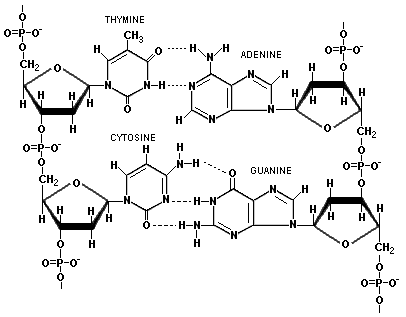A research team at Cornell University recently created a new type of hydrogel. Opposed to the other hydrogels we have written about in this blog before, this hydrogel is made not of gelatin, but of DNA This hydrogel is particularly fascinating, to us and to Cornell University Professor Dan Luo as well, because the hydrogel consists of a solid shape when it is filled with water but loses this shape when the water is removed. Without water, the material behaves as a liquid, able to be poured into containers and retain the container's shape. Thus, it is referred to as "solid when wet and liquid when dry."
 |
| The effects of removing and reintroducing water to the DNA hydrogels |
 |
| Chemical structure of DNA |
For those of you who are having trouble actually imagining what this hydrogel would look like as a "solid when wet and liquid when dry," it can be compared to the Terminator T-1000 of the movie, Terminator 2. This character, if you recall, was made of liquid metal and was able to "quickly liquify" and "assume different forms." Similarly, this DNA hydrogel, with the removing and addition of water, can quickly morph into a different shape. Although this hydrogel will certainly not be used for violent purposes such as Terminator T-1000, it has a variety of other applications.
Because of its chemical properties, the DNA hydrogel can be utilized for 3D tissue scaffolding and biomedical applications. In particular, DNA hydrogels are different from other hydrogels because their polymer networks, under specific conditions, are formed spontaneously. Just like we learned in class, spontaneous reactions occur without an external driving force; or in other words, these reactions can occur naturally. The polymer networks then form spheres that weakly-bond to one another. Although weak bonds, these bonds are what hold together the shape of the hydrogel. Without the bonds, the hydrogel, when wet, would simply be a mixture of DNA without a structure of some sort. What is specifically interesting to us is that when the water in this DNA mixture is removed, the DNA collapses into a liquid form, able to be poured into molds of certain shapes and to adapt to these shapes. Even when water is added back, the DNA hydrogel remembers this structure and retains this shape when more solid.
Although it is not certain how the DNA hydrogels are able to preserve their shapes, it is very useful. For example, applications such as injectable stents can utilize this behavior in order to be properly place into the body. Large quantities of water would allow the creation of the injectable stent's shape. When the liquid is removed, the injectable stent would be injected into a particular section of the body as it is a fluid, capable of traveling easily. When in the body part, the stent would revert to its original shape. To us, this is one of the most interesting inventions we have seen in the topic of hydrogels, and in terms of tissue engineering, in general.
http://www.gizmag.com/dna-hydrogel-solid-liquid-cornell-luo/25402/
No comments:
Post a Comment